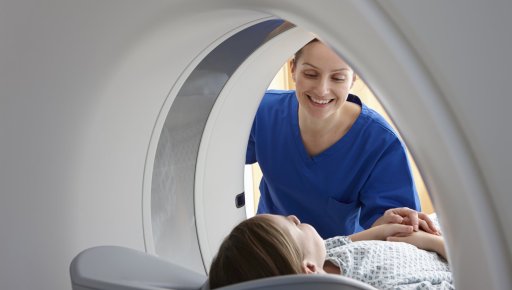According to the Bureau of Labor Statistics, employment in the healthcare field is projected to grow between 15–16% over the next decade—much faster than the average for all occupations, adding about 2.4 million new jobs by 2029. This blog explores five in-demand healthcare jobs that are among the fastest-growing healthcare jobs of the next decade.
Nurse Practitioner
Nurse Practitioners are expected to see a growth rate of about 52% from 2019 to 2029—the quickest in the healthcare field. A Nurse Practitioner (NP) is a highly trained and specialized advanced practice registered nurse (APRN) who plays a crucial role in healthcare delivery. NPs are trained to provide a wide range of healthcare services, including diagnosing and treating illnesses, prescribing medications, and managing overall patient care. Here are some key aspects of the Nurse Practitioner profession:
1. Education and Training
- NPs typically hold a Master of Science in Nursing (MSN) or a Doctor of Nursing Practice (DNP) degree. The educational path includes both classroom education and clinical training.
- The curriculum covers advanced health assessment, pathophysiology, pharmacology, and specialized courses related to the chosen NP focus area (e.g., family, adult-gerontology, pediatric, psychiatric-mental health).
2. Licensing and Certification
- NPs must be licensed as registered nurses (RNs) and then obtain additional certification as advanced practice nurses in their specific NP specialty.
- Certification is often provided by organizations such as the American Nurses Credentialing Center (ANCC) or the American Association of Nurse Practitioners (AANP).
3. Scope of Practice
- NPs have an expanded scope of practice compared to registered nurses. They can diagnose and treat medical conditions, order and interpret diagnostic tests, prescribe medications, and develop treatment plans.
- The specific scope of practice can vary by state and is often determined by state laws and regulations.
4. Specialties
- NPs can specialize in various areas, such as family health, adult gerontology, pediatrics, women's health, psychiatric-mental health, and acute care. Each specialty focuses on specific patient populations and healthcare needs.
5. Collaboration and Autonomy
- NPs often work collaboratively with physicians, other healthcare professionals, and support staff. However, they also have a degree of autonomy in their practice, allowing them to make clinical decisions independently.
6. Primary Care Providers
- Many NPs work as primary care providers, offering comprehensive healthcare services to patients of all ages. They can provide preventive care, manage chronic conditions, and address acute illnesses.
7. Patient Education and Advocacy
- NPs place a strong emphasis on patient education and health promotion. They work to empower patients to take an active role in their healthcare and advocate for their well-being.
8. Continuing Education
- NPs are committed to ongoing professional development and continuing education to stay current with advancements in healthcare and maintain their certifications.
Nurse Practitioners play a vital role in improving access to healthcare services, particularly in underserved areas. Their advanced training and skills contribute to the overall quality and efficiency of healthcare delivery.
Respiratory Therapist
Respiratory therapists treat patients with heart and lung problems such as asthma, chronic bronchitis, emphysema, pneumonia, chronic obstructive pulmonary disease and sleep apnea. They perform diagnostic tests for lung capacity, administer breathing treatments, document patient progress, and confer with physicians and surgeons. Employment of respiratory therapists is forecast to grow 19 percent from 2019 to 2029, according to the BLS. Here are key aspects of the Respiratory Therapist profession:
1. Education and Training
- Respiratory Therapists typically hold an associate's or bachelor's degree in respiratory therapy from an accredited program.
- Educational programs cover topics such as anatomy, physiology, pharmacology, and therapeutic and diagnostic procedures related to the respiratory system.
2. Licensing and Certification
- Respiratory Therapists must be licensed in the state where they practice. Licensing requirements vary by state.
- Many respiratory therapists also pursue certification, such as the Certified Respiratory Therapist (CRT) and Registered Respiratory Therapist (RRT) credentials, which are offered by the National Board for Respiratory Care (NBRC).
3. Scope of Practice
- RTs specialize in the assessment, treatment, and management of patients with respiratory and cardiopulmonary conditions. They provide care for patients with asthma, chronic obstructive pulmonary disease (COPD), pneumonia, and other respiratory disorders.
- Responsibilities may include conducting diagnostic tests, administering therapeutic treatments, and managing mechanical ventilators.
4. Settings of Practice
- Respiratory Therapists work in various healthcare settings, including hospitals, clinics, nursing homes, and home healthcare. They may also work in emergency and critical care environments.
5. Collaboration with Healthcare Team
- RTs collaborate closely with physicians, nurses, and other healthcare professionals to develop and implement treatment plans for patients with respiratory issues.
6. Emergency and Critical Care
- Respiratory Therapists often play a crucial role in emergency and critical care settings. They may be involved in resuscitation efforts, manage ventilators for critically ill patients, and assist in the stabilization of patients with respiratory failure.
7. Patient Education
- RTs educate patients and their families on respiratory conditions, treatment options, and self-management strategies. This education is essential for promoting adherence to treatment plans and improving overall patient outcomes.
8. Pulmonary Rehabilitation
- Some respiratory therapists work in pulmonary rehabilitation programs, helping patients with chronic respiratory conditions improve their lung function and overall quality of life through exercise and education.
9. Advocacy for Respiratory Health
- Respiratory Therapists may engage in advocacy efforts to promote respiratory health and raise awareness about the importance of respiratory care.
10. Continuing Education
- Like other healthcare professionals, respiratory therapists participate in ongoing education to stay abreast of new technologies, treatments, and developments in the field.
Respiratory Therapists play a critical role in the management of respiratory disorders, contributing to the overall well-being of patients with breathing difficulties. Their expertise is especially valuable in acute care settings and in the ongoing management of chronic respiratory conditions.
Occupational Therapy Assistant
Occupational Therapy Assistants (OTAs) are allied healthcare professionals who work under the supervision of licensed occupational therapists. Here are some of the key aspects of the profession:
1. Education and Training
- OTAs typically complete an associate's degree program accredited by the Accreditation Council for Occupational Therapy Education (ACOTE).
- Educational programs include coursework in anatomy, physiology, occupational therapy principles, and hands-on clinical experience.
2. Licensing and Certification
- OTAs must be licensed or registered in most states. Licensing requirements vary by state.
- Certification is often obtained through the National Board for Certification in Occupational Therapy (NBCOT).
3. Scope of Practice
- OTAs work with occupational therapists to help individuals of all ages with physical, developmental, or emotional challenges to participate in daily activities and improve their quality of life.
- They implement treatment plans, facilitate therapeutic activities, and provide interventions to help clients achieve their occupational goals.
4. Settings of Practice
- OTAs work in a variety of settings, including hospitals, rehabilitation centers, schools, and community-based facilities. They may also work in home healthcare.
5. Collaboration and Communication
- OTAs collaborate closely with occupational therapists, as well as with other healthcare professionals, educators, and family members, to ensure a holistic and client-centered approach to care.
6. Adaptation and Assistive Devices
- OTAs may assist in the selection and training of adaptive equipment and assistive devices to help clients overcome challenges in their daily activities.
7. Patient Education
- OTAs educate clients and their families on therapeutic techniques, adaptive strategies, and exercises to promote independence and improve functional abilities.
OTAs are essential members of rehabilitation teams, contributing significantly to the overall care and well-being of individuals undergoing occupational and physical therapy. They work closely with therapists to implement treatment plans and provide valuable support to help clients achieve their therapeutic goals.
Home Health Aide
According to data from the U.S. Census Bureau, the number of older Americans is projected to increase by almost 18 million over the next 10 years as the last of the baby boomers turn 65. As a result, the overall employment of Home Health Aides (HHAs) is expected to jump 34 percent from 2019 to 2029, according to the Labor Department. HHAs represent the sixth-fastest growing occupation in the country, according to Labor Department data.
HHAs are crucial members of the healthcare team who provide essential support and assistance to individuals who need help with daily activities.
1. Education and Training
- Home Health Aides typically receive training through formal programs offered by community colleges, vocational schools, or home health agencies.
- Training includes basic healthcare skills, personal care techniques, and sometimes additional specialized training based on the specific needs of the clients.
2. Responsibilities
- HHAs provide assistance with activities of daily living (ADLs), such as bathing, dressing, grooming, and mobility support.
- They may also assist with basic health-related tasks, such as checking vital signs, administering medications (under the supervision of a nurse), and helping with exercises prescribed by healthcare professionals.
3. Settings of Practice
- HHAs primarily work in clients' homes or residential care facilities. They may be employed by home health agencies or may work independently.
4. Client Population
- HHAs often work with individuals who are elderly, disabled, or recovering from illness or surgery. They provide personalized care to help clients maintain independence and enhance their quality of life.
5. Emotional Support
- HHAs may offer emotional support and companionship to clients, as they often develop close relationships with those under their care.
Home Health Aides play a critical role in supporting individuals who require assistance to maintain their independence and well-being. They contribute significantly to the growing field of home-based and community-based care, providing essential services to diverse populations.
Mental Health Specialist
Employment of substance abuse, behavioral disorder, and mental health counselors is likely to grow 25% from 2019 to 2029, according to the Labor Department—further boosting current growth. Within this specialization, the fast-growing positions include behavior therapist, mental health technician, and psychotherapist.
Behavior Therapist
1. Education and Training
- Behavior Therapists typically have at least a master's degree in psychology, counseling, applied behavior analysis, or a related field.
- Training often includes coursework in behavior analysis and supervised practical experience.
2. Responsibilities
- Behavior Therapists focus on understanding and modifying behavior. They use evidence-based interventions, often rooted in behavior analysis, to address a variety of behavioral issues.
- Applied Behavior Analysis (ABA) is a common approach, particularly in working with individuals with autism spectrum disorders and other developmental disabilities.
3. Settings of Practice
- Behavior Therapists may work in schools, clinics, hospitals, residential facilities, or provide in-home services.
4. Collaboration
- They often collaborate with families, educators, and other professionals to create and implement behavior intervention plans.
Mental Health Technician
1. Education and Training
- Mental Health Technicians may have a high school diploma, though some positions may require additional training or certification in mental health or related fields.
2. Responsibilities
- Mental Health Technicians provide direct care and support to individuals with mental health conditions. Their duties may include assisting with daily activities, observing and reporting patient behavior, and facilitating therapeutic activities.
- They work under the supervision of mental health professionals, such as nurses, psychologists, or psychiatrists.
3. Settings of Practice
- Mental Health Technicians work in various settings, including psychiatric hospitals, residential treatment centers, and community mental health facilities.
4. Patient Interaction
- They have direct and frequent interaction with individuals receiving mental healthcare, providing both emotional and practical support.
Psychotherapist
1. Education and Training
- Psychotherapists typically hold advanced degrees, such as a master's or doctoral degree in psychology, counseling, social work, or a related field.
- They undergo extensive clinical training, which may include supervised internships or practicum experiences.
2. Responsibilities
- Psychotherapists provide talk therapy to individuals, couples, or groups to address emotional, behavioral, or mental health issues.
- They use various therapeutic approaches, such as cognitive-behavioral therapy (CBT), psychodynamic therapy, humanistic therapy, or other evidence-based modalities.
3. Settings of Practice
- Psychotherapists work in private practices, community mental health centers, hospitals, and other healthcare settings.
4. Diagnosis and Treatment Planning
- They assess clients, make diagnoses when appropriate, and develop treatment plans tailored to the unique needs of each individual.
5. Client-Centered Approach
- Psychotherapists create a therapeutic alliance with clients, offering a safe and confidential space for exploration, self-reflection, and personal growth.
It's important to note that these roles often intersect, and professionals in these fields may collaborate to provide comprehensive care for individuals with mental health challenges. The specific duties and qualifications can vary based on the setting, the population served, and the local regulations governing these professions.
Secure a Fast-Growing Healthcare Job with Prolink
Prolink is here to help you make the next move in your career. You’ll be assisted by a dedicated team of recruiters throughout the entire process, helping you find an optimal position, location, and benefits package for your needs.









